PC Engine build
-
About a week ago @FlyingTomahawk sent me an absolutely fantastic gift - a PC engine in beautiful condition. It's a console I've wanted since I was a child so to finally have one is amazing - I'd never even seen one in real life until I received it. I have already thanked @FlyingTomahawk but I'd like to say thank you again as it was such an amazing and generous gift. It's actually the second console he sent me as he already sent me a Famicom which I'll also be working on in the future.
I have been looking for a pc engine for ages to convert to a retropie machine but now I had one I was initially hesitant as this is a working machine and they are fairly rare over here. I decided though that as it would need various mods to even get it working on a TV over here that I will convert it - however I'm being very careful so that at a later date it could be returned to an almost original state if needed.
Now for some pics:
This is the console as it arrived, apart from a few marks you can see it's in very good condition and shows no sign of yellowing. I've since given the shell a thorough clean and it looks almost as good as new.
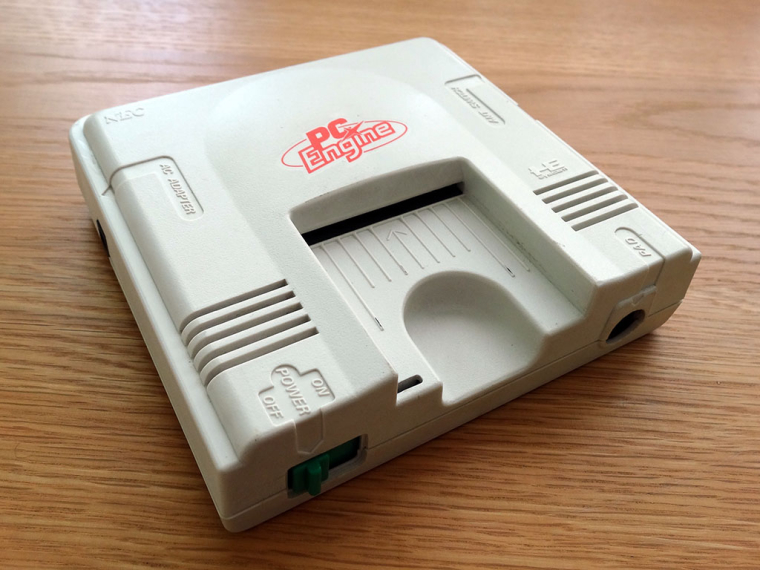
This is the inside of the machine after opening the case, they really didn't waste any space.
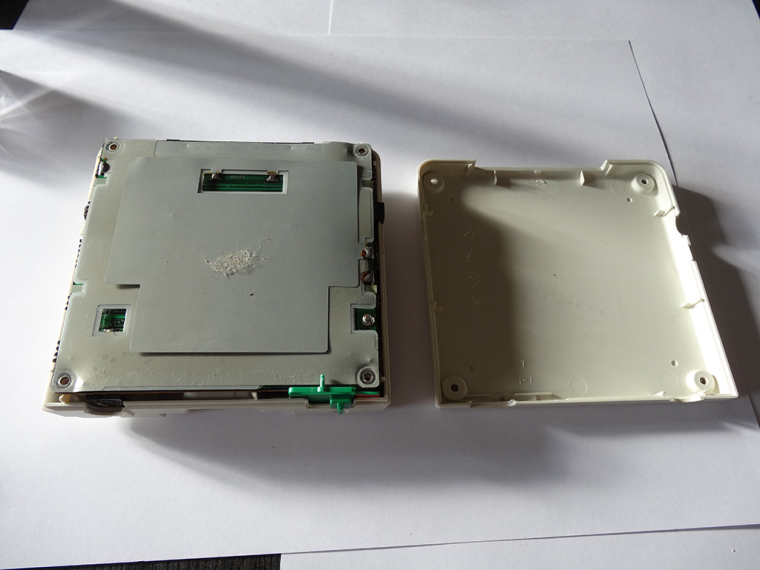
This shows the main motherboard being removed, you can see the Hucard slot connected via a hefty ribbon cable.
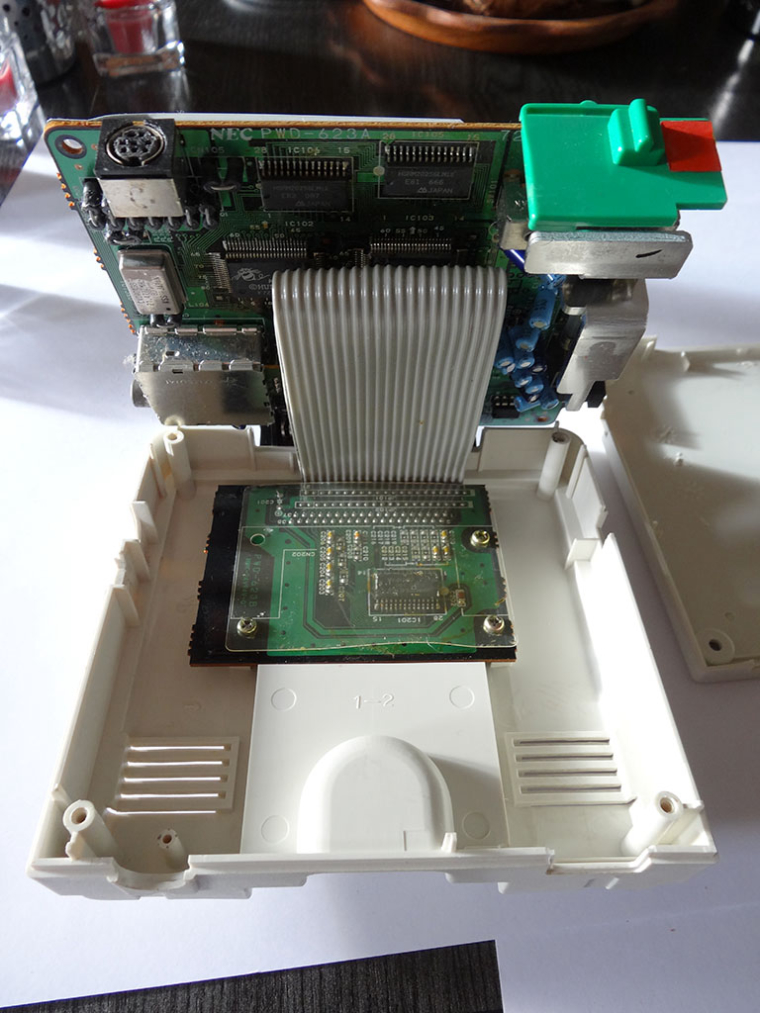
I was convinced this would be a difficult build due to the small size of the console but as it happens this will be the easiest build I've attempted. The shell is almost a perfect match for the rpi. If you place the pi here then you have easy access to to the hdmi and power.
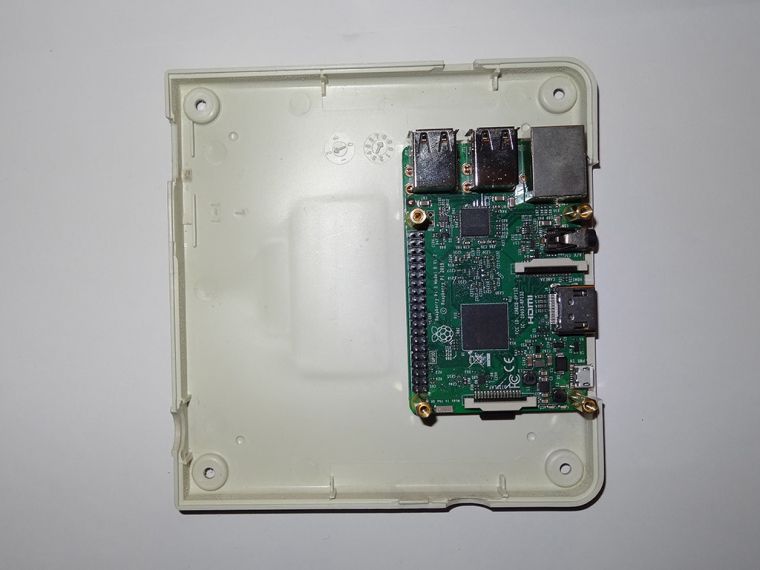
Here is the rear view showing that the HDMI and power are accessible.
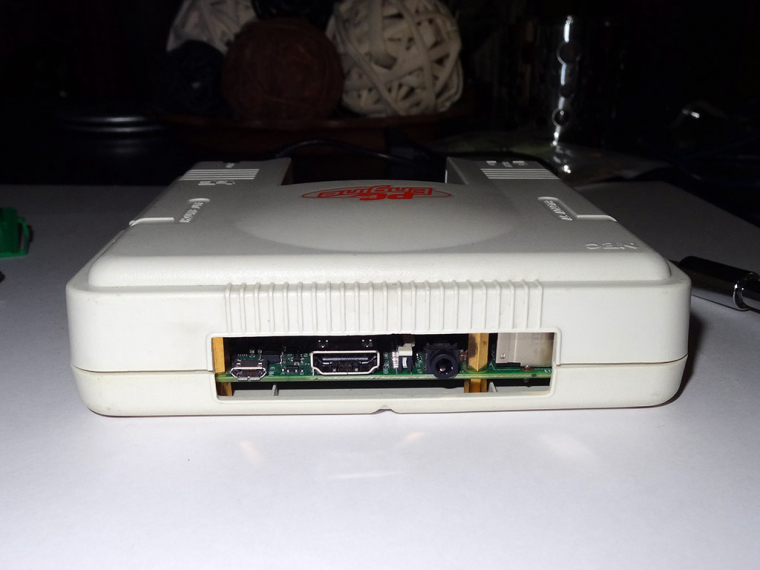
My build will be slightly more complicated as I'm going to use a powerblock so that I can power the system on and off using the original power switch, this means I can't power it via the micro usb. By complete luck a faulty PC engine motherboard was up for sale on Ebay UK for a very low price of £5 so I snapped that up and can use it for the power switch, cartridge slot, controller port, and power socket. The only modification I will need to make to the shell are to drill 4 holes in the base to secure the RPI which I feel is a very minor modification.
I plan to wire up the the controller port to a usb cable like I did on my Super Famicom build so I can plug in any usb device. I also plan to use an SD card extension lead which will fit where the original AV port was so I can access the SD card without dismantling the system.
I've already salvaged the cartridge port from the spare motherboard. It wouldn't all fit with the entire board so I cut the pins and separated the slot itself from the PCB and screwed it back in place. This won't be functional in any way but it will be nice to be able to have a Hucard in the system as decoration.

One last photo showing the PC Engine shell next to my Super Famicom so you can see how small it is. - it's sooo cute :D
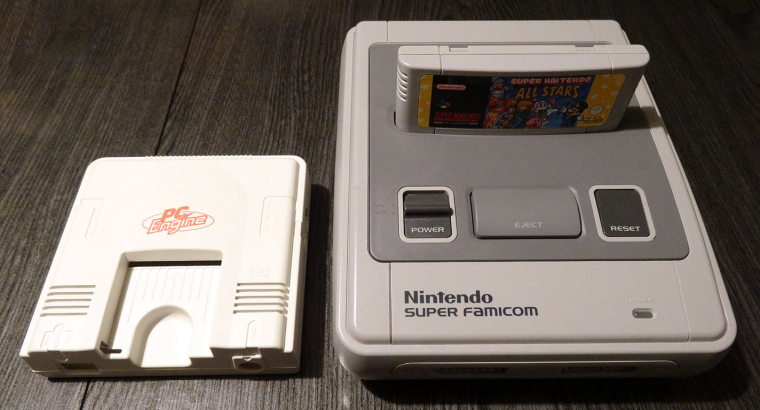
I just need to wait for the Powerblock to arrive now and I can make some more progress. I also need to make a custom PC engine theme for it as all my systems have to have a unique theme :) .
-
wow can't wait to see the finished product!
-
@ruckage This will be a great project!!!
-
I've been thinking of doing one myself. Looks like ebay sucks right now. I'll keep a look out. I do wonder if you can solder a very thin usb stick to a hucard pcb, then solder a usb cable to the cart slot so there's purpose in using it. It's what I did to my sfc pi but that was easier since there's so much room.
-
@darksavior
Hi. I've actually been thinking the same thing myself the last few days though using an sd card extension cable instead of a USB stick. Annoyingly though in my haste I cut all the pins on the cartridge slot as I hadn't planned to use them - I think I can still solder to the remains of the pins though. -
@ruckage Good luck. I tried to make an sd card extension cable for my sfc pi, but it wasn't reliable. I did find something that might work for usb. The Kingston FCR-MRG2 usb to microsd card reader. It's really tiny.
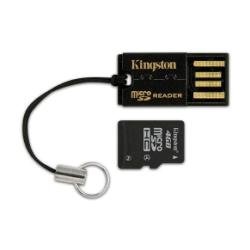
Though, I have no experience with hucards or how to open them to get a visual on how it would be possible. I would love pictures if you decide to go through with it.
-
@darksavior
Thanks. What kind of problems di you have with the SD extension cable - any ideas what caused the problems?
My idea is to use a ready made SD extension cable and modify that (they seem to work well as I have one in my SFC build).There is actually very little to most hucards - everything is contained within the black area which does make things tricky though still possible, the rest is just solid plastic.
-
@ruckage No matter how good of a connection my soldering was, the connection was unstable. I used a multimeter to check too. I also tried a premade extension cable an cut the cable and used my wires. I was looking up ideas for the sfc, and I stumbled onto someone's sfc pi project and he also came to same conclusion. With USB it was 4 wires and that just gave me minor problems which was easily fixed..by scratching out the parts around the 4 pins on cart and cart slot to isolate them from the rest of the circuit.
Ah, OK, so that black part is the pcb.
-
@darksavior
Thanks for the reply.I'm actually thinking now that I may just go the NFC tag route. It's a gimmick I know but I really like the idea of recreating the whole experience - physically browsing through game cards would be very nostalgic. I had thought about it for my Neogeo and SFC builds but decided against it but it seems a perfect fit for this build as I can easily and cheaply produce fake hucards as they are such a simple design and would be fun to make.
I need to do some research though - I need it to work alongside the powerblock which itself takes up some gpio pins so I guess a USB NFC reader would be the way to go. I'd need it to read the NFC as soon you boot up the console and then launch the inserted game directly completely bypassing EmulationStation. At the moment I only have vague ideas about how to achieve all this but I know others have made similar builds so hopefully I can learn from them.
-
@ruckage You might want to look at this page for NFC inspiration: http://www.daftmike.com/2016/07/NESPi.html
Also, would you just 3d-print a whole bunch of Hu-Cards? Or would you buy cheap games and gut them?
-
@lilbud Thanks, yeah i had seen that one - it's definitely a good source for some ideas.
Even buying cheap Hucards would get expensive as the cheapest available in the UK are £4 each - obviously that would add up quickly if I wanted to make a lot of cards (which I do :) ).
3d printing would also be expensive and very slow.Luckily the Hucard is a very simple design as it's more or less just a rectangle. I know someone who does laser cutting so I'm thinking that having the Hucards cut from acrylic and then making full face labels myself that replicate the look of the Hucard will be a pretty good approximation and should hopefully be affordable.
-
@ruckage sounds good!
-
@ruckage I don't know if this is part of your plan, but a transparent replica of Hucard could be an awesome thing!!! Will look like a crystal special edition!!! 😁
-
I've been playing around and have designed a nice label I can use for the replica Hucards and once I printed one out as a test I realised the size looked very familiar - turns out Hucards are exactly the same size as a credit card. I know they are always described as 'credit card sized' but wasn't aware it was quite so literal.
This now gives me another option - I could just buy NFC cards and use those. Obviously they would be much thinner than a real Hucard but would definitely be very cost effective.
-
@ruckage I found a video showing a similar project using NFC with Raspberry Pi to simulate Snes cartridges. Take a look:
-
It's been a long while since I posted an update but I've made some major progress now. I have my NFC reader working now and using python I can retrieve the rom name from the nfc tag and launch the rom. This was my main hurdle so now I have that working I should be able to progress much more quickly.
I had trouble originally for 2 reasons. The NFC reader I originally bought was fake and I was using spi to connect the nfc reader to the pi.
The problem with the fake reader was that its range and reliability were not very good. In the end I bought a reader directly from Elechouse and the range/reliabilty is much better.
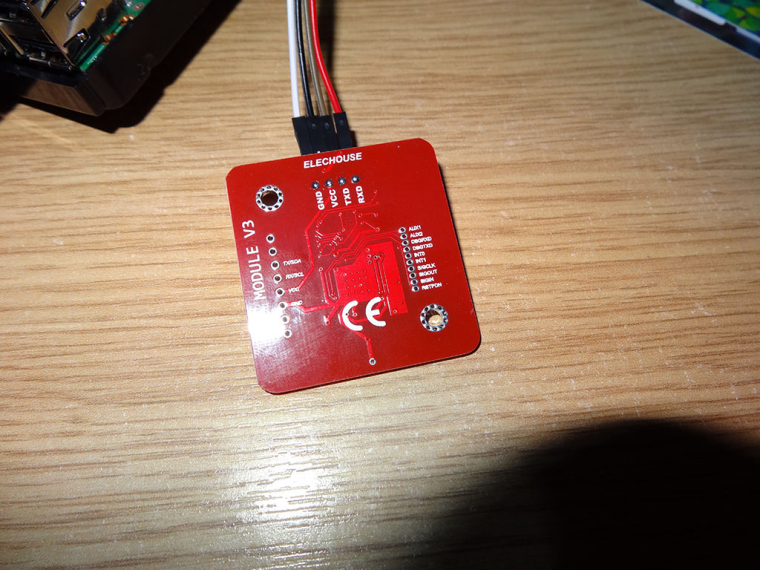
The problem with spi was that I couldn't find a way to access the ndef data. So after finding a tutorial online I switched to uart and now I can use NFCPY to access that data. Through trial and error I modified an example python program to achieve what I wanted, I admit I am lost when it comes to python as I've never used it before but the code seems to work as expected which is what matters.
I've also had loads of HuCard blanks laser cut from acrylic in preparation. I also had some problems in that regard as the first batch I received weren't cut correctly but luckily the person who cut them for me was happy to cut them again.
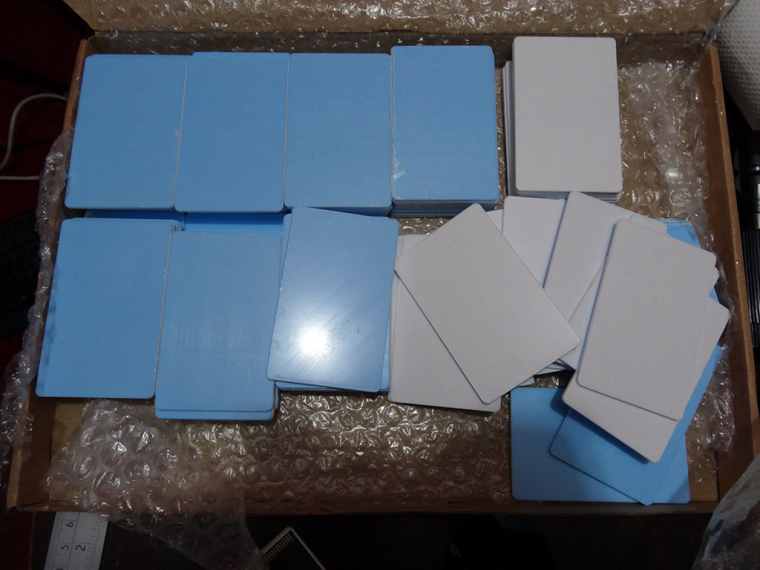
Finally here is quick test I did to see how the cards will look once I apply the labels I'm making.
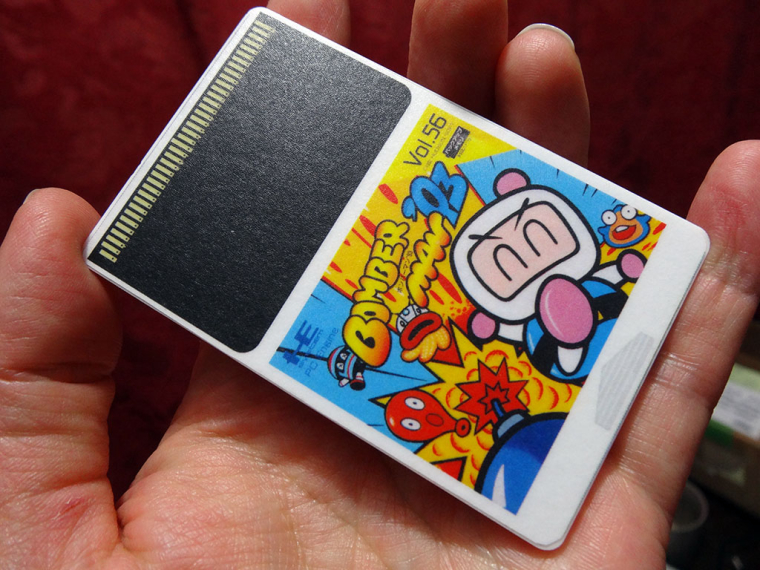
-
I've been trying to get this to boot as fast as possible, so far it takes 13 seconds from the rainbow square to when the game starts which isn't bad but I'd still like to improve that if possible. I've read that removing/disabling samba may help so once everything is setup I may give that a go.
I have a speedy SD card (sandisk extreme plus), and I've set the pi to not wait for network on boot which always makes a big difference. I also tried oveclocking the SD card but I didn't notice any real improvement to the boot time. Any other suggestions would be welcome.I've made a loading animation so at least for those 13 seconds it looks interesting. It's inspired by some Hudson Soft trailers I saw which featured 2 Bombermen kicking a bomb to each other. I used sprites and a background from a few different Bomberman games (with some editing) to make the splash animation. I think bomberman is a pretty good mascot for the system but I may do a few others featuring Bonk and Air Zonk as they are the more official mascots and I can have a random boot animation each time.
If anyone is interested in having the splash video I can make a more generic version by replacing the 'PC engine' logo with the 'Retropie' logo.

Out of curiosity is there any way to force the splash video to stop as soon as retropie has finished booting (or in my case when runcommand is launched?) It would save having to trim videos to an exact size to fit the boot time. I could just have a longer video then which would stop automatically. Even better would be the ability to have a short looping video which could loop repeatedly until retropie has finished booting (I'm fairly sure that isn't possible though ).
-
@ruckage said in PC Engine build:
Even better would be the ability to have a short looping video which could loop repeatedly until retropie has finished booting (I'm fairly sure that isn't possible though ).
Anything is possible with the magic of programming. You'd probably have to have a script or daemon of sorts that loops until emulationstation is called or something.
I haven't looked at it since it's switched to systemd but you should be able to modify the boot script to cut out once es loads
-
Your attention to detail on these builds is incredible! Great work as always!
-
@ruckage said in PC Engine build:
...and I've set the pi to not wait for network on boot
How did you do that? My FamicomPi takes also longer to boot up and mostly because of the network check.
Awesome work on the splashvideo!
Contributions to the project are always appreciated, so if you would like to support us with a donation you can do so here.
Hosting provided by Mythic-Beasts. See the Hosting Information page for more information.